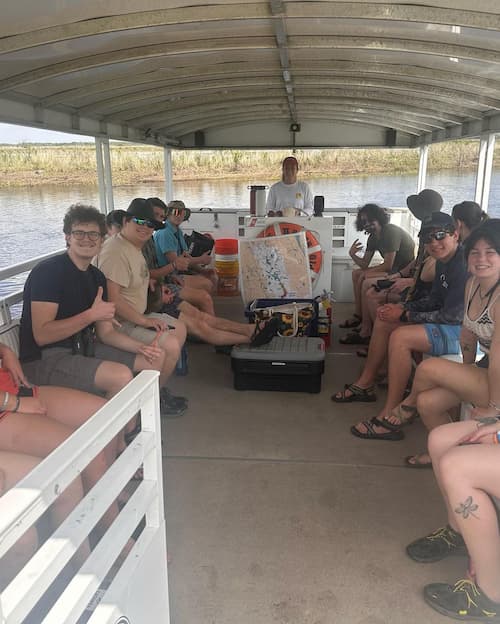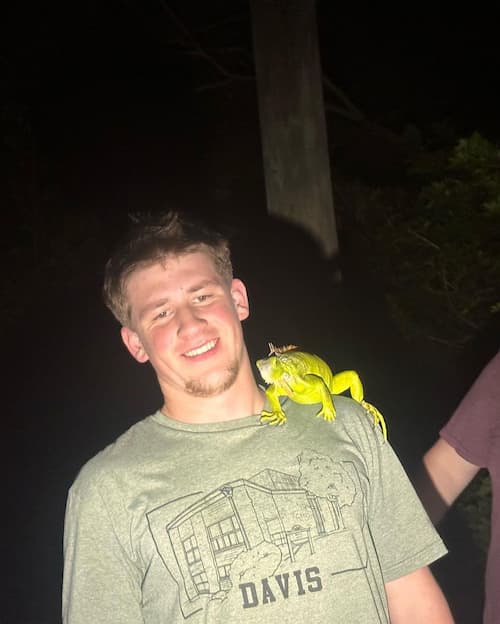Fifteen Montreat College students adventured on a five-day, four-night excursion to the wetlands of Florida as part of their Field Studies coursework this semester.
Under the guidance of Dr. Anna Hardy, Assistant Professor of Natural Science, and Dr. Josh Holbrook, Assistant Professor of Biology and Environmental Science, the group spent two nights in Lorida, Florida, on the banks of the Kissimmee River, and two nights camping in Big Cypress National Preserve. The trip provided a firsthand look at the critical habitat provided by wetlands and human impact on the environment.

“Wetlands, pound for pound, are one of the highest biodiversity places on Earth,” Dr. Holbrook said. “In other words, they have more species of plant and animal than almost any other habitat, and they also produce the most plant and algae biomass that is food for everything else. We call that primary productivity. Wetlands are tied with coral reefs and tropical rainforests as being the highest in primary productivity.”
For Dr. Holbrook, the bi-annual trip is a homecoming of sorts.
“I did most of my undergraduate and graduate work in Florida. I lived there for almost ten years and really didn’t run out of things to do,” he said. “We can easily slide from thing to thing down there and see all that Florida has to offer in terms of the different wildlife, the birds, the snakes, and the reefs, so it is a packed place.”
Highlights of this year’s trip included surveying approximately 40 species of birds, finding shark teeth and a massive mastodon tooth along a river beach, snorkeling, and witnessing an alligator devouring a wild boar in the water. Another sighting of interest was chameleons, a non-native exotic species in Florida. Dr. Holbrook has previously been featured on National Geographic while collaborating with other universities to study the reptiles in South Florida.
“Chameleons are always a fun and exciting species for the students to see,” Dr. Holbrook said. “There’s also a snake species down there called a mangrove salt marsh snake that I have worked with quite a bit with some of my collaborators in Florida, and we found a couple of those. They’re very friendly snakes. You can pick them up and they’ll just hang out there in your hand, no biting.”
Another significant aspect of the trip was a boat ride where students observed the Kissimmee River restoration, the second-largest environmental restoration project in history. In an effort to control flooding, the meandering river was transposed into a deep and straight canal in the 1960s through federal assistance and the work of the United States Army Corps of Engineers. The project nearly halved the river’s length between Lake Kissimmee and Lake Okeechobee from 103 miles to just 56 miles. However, the changes to the river did not produce the intended results. Since 1997, attempts have been made to restore the floodplain to its original state and reverse the devastating consequences the project had on the local ecology.

“One of the problems they’ve had with the Kissimmee River is actually increased flooding because they’ve taken something with a big wide floodplain, which is a big wetland essentially, and turned it into this narrow channel that can overspill easily,” Dr. Holbrook explained. “In terms of human benefit, wetlands are important for things like flood control because they’re a big sponge on the landscape that’s able to suck up and hold onto water from rains.”
While this year’s group ventured to southern Florida, future Field Studies trips will rotate between visits to northern Florida, the Carolina coast, Great Smoky Mountain National Park, and the ancient dune system of the Carolina Sandhills.
“For labs or classes, we may go half an hour or an hour away, but these Field Studies classes give us more time, so more distance, to get away and see more cool stuff,” Dr. Holbrook said. “Because we’re small enough at Montreat, we’re able to get students out in the field a lot earlier than anywhere else. In a typical larger university, especially a large state college, you don’t get out into the field until your junior year, and that’s usually just locally.”
Overall, Dr. Holbrook appreciates these field trips not just for their educational value, but also for the unique opportunity they offer to build deeper connections with his students.
“These trips are great for being able to get out there with the students because you get to know them a lot better doing field work than you do in the classroom,” Dr. Holbrook said. “I’ve always enjoyed the opportunity to take people out and see people get excited about things I may have seen 1,000 times. That’s pretty cool to be able to feed off other people’s excitement.”